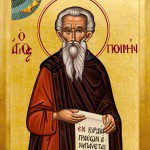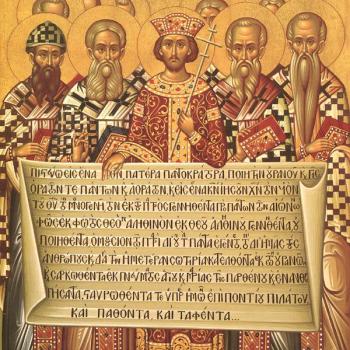
Most religious traditions have texts, Scriptures, which they used to guide and direct their faithful, providing them at least a basic representation of their teachings. There are, of course, limits to what can be provided in such texts, and many, if not most, religious faiths recognize this as a basic fact. They point out the faithful need to do more than read and reflect upon scripture; the faithful need to actually engage them, to live out what is indicated in them, to experience the truths of the faith, so as to come to know and understand the faith in a way which transcends what can be said or written down. This is not to say scriptures are without value; they serve as norms, helping to make sure that the faithful have the foundations necessary to explore and deepen their faith.
It is important, therefore, for people, religious and non-religious alike, to know and understand the strengths and weaknesses of scriptural texts. They serve as guides. They are not meant to teach everything that is possible for one to come to know and believe from a particular religious tradition. Nor are people expected to simply read the text and take the most simplistic, and often the most literalistic, interpretation of the text and assume that is what was intended by its author or the religious tradition which uses the text as a scripture. Religious texts, especially scriptures, are meant to reveal something to us, to show us or explain to us something which we did not previously apprehend or understand, something which, moreover, difficult if not impossible for us to come to know without inspiration (that is revelation). Once we accept a text, once we accept the authority it has been given, we are to engage it, to examine and reexamine it as we come to experience the truth which it reveals in our own lives, for in this fashion, we will learn that holy scriptures tend to have multiple layers of meaning contained within them. Each time we think we have learned what it means, we experience that meaning in our lives, and that experience gives us a new hermeneutic by which we read the text, and discern new things, new meanings within it. Our hope should be that the more advanced we become in our experience and understanding of our faith, the more, not less, we will get out of scripture, seeing that it can and will continue to point out new spiritual experiences and understandings. What is important is that we find a way to engage scripture, and use what we learn to improve our spiritual life and our spiritual experience, even as we then use our spiritual experience and apprehensions, combined with our reason, to engage scripture, so that Scripture and our experience, far from contradicting each other, end up complementing each other, working together as if we were dealing with some kind of triangulation.
When we do this, hopefully we will begin to understand the various contexts and audiences which led to the production of the different texts contained within scripture. This will help us understand where a particular text is coming from, and using that knowledge, we can better understand what transcendent truth is meant to be conveyed in the text. In this fashion, moreover, we will better understand how many apparent contradictions in scripture are not contradictions, if we look to where they are pointing to, instead of where they are coming from (similar to the way, if someone were to ask how they were to get to Washington D.C, where the question is asked will lead to a different answer, which, if different answers are put side by side without reference to the context in which the question was asked, the answers might appear to contradict each other, when in reality, they all point to the same end, showing that the contradiction was merely apparent and not real).
Scripture was written by many authors, dealing with many particular needs, and so it is necessary to lay out those perspectives, to see how they work together beneath their apparent contradictions, in order to see how they work together and point to the same ultimate conclusion. Often, exegetes suggest that we should do more than this; they say we need to know or determine for ourselves the proper key to unlock the meaning of the texts, that is, we need to also find the central link which connects the various texts found in a scriptural tradition together, for only then it will be possible for us to understand that is meant to be taught by scripture. Thus, for example, Tsong-kha-pa, an influential Tibetan Buddhist sage, said we must understand what the ultimate truth the Buddha was conveying and use that to determine if a text is said to represent a provisional (conventional) representation of the Buddhist dharma, or a definitive representation of it. Thus, he believed the key to unlocking the great diversity of Buddhist scriptures was the Mādhyamika doctrine of the two truths, the conventional truth which is the truth as it can be understood through conventions (and, likewise, then the truth as things appear to be in relation to phenomenal experience), and the ultimate truth (the emptiness of all phenomena), with the realization that provisional texts all represent engagements with conventional truths:
What sort of scripture is definitive and what sort is provisional? This is determined by way of the subjects they discuss. Those that teach the ultimate are considered scriptures of definitive meaning and those that teach conventionally are considered scriptures of provisional meaning. [1]
The final reality, the final, absolute truth, the ultimate truth, must be seen as being represented, in some fashion or another, in all Buddhist texts. All that is conventional, all that is provisional, must be understood as serving the ultimate truth, albeit indirectly. This means those texts which are considered provisional are to be read with the understanding that though they point to and disclose the truth, we must not confuse the convention used in them with the absolute truth, which means, such a text is not likely to be literal, or if it were, it is only meant to be engaged temporarily before it is transcended:
The provisional, or that which requires interpretation, is a text that cannot be taken to mean exactly what it says; rather, you must explain what it intends, interpreting it as having some other meaning. Or, it is a take that can be taken literally, but in which this literal meaning is not the final reality, and you must still seek that reality as something other than the conventional phenomena to which the text refers. [2]
Because of the relationship between the two truths, even those texts which are deemed provisional, that is, those which present some element of the truth, but not the ultimate truth as its focus, nonetheless are not to be dismissed and rejected, because most such texts indirectly point to the ultimate truth: “Generally, among all the Conqueror’s scriptures there are some that explicitly teach about reality, and even those that do not explicitly teach it nonetheless indirectly point toward it.” [3] Buddhists texts were written for a variety of people, for a variety of contexts from which a reader can be at, so that they come from a variety and perspectives, engage people where they are at, and work to help direct them further to the ultimate truth. This is why various texts, when read without care and attention, can seem to contradict each other, and so lead us to being confused. We must learn how to engage them, and then the more we take what we learn and put it into practice, the better we will appreciate and understand what we read, and in doing so, understand the unity behind them all. Nonetheless, Tsong-kha-pa thought it important for us to recognize that it can be difficult for us when we first engage various texts, and so said we should not be discouraged if we are initially confused:
Even if you do not understand the teachings from the outset, do not be discouraged, but strive to study them in accord with your mental capacity, as much as feasible, whether that be a little or a lot. Do not make study and practice into separate things. Rather, the very thing that you practice must be exactly what you first study and reflect upon. [4]
We see a similar strategies as the one suggested by Tsong-kha-pa coming from the Christian tradition. All Christian scriptures are said to be pointing to one ultimate truth. And just as Tsong-kha-pa taught, Christian texts can be seen doing this either indirectly, and so in some provisional manner, and directly, that is, definitively. The difference, of course, is that for Christianity, the ultimate truth is not śūnyatā, that is, emptiness (although there are ways Christians can engage the concept of śūnyatā and see how it connects to the Christian faith); rather, it is the truth of Christ, that is, the disclosure of the Triune God of love in the person of Jesus Christ. Moreover, in presenting the ultimate truth in himself, Jesus also gave us the key to uncover the greatest meanings present within all scripture: “You search the scriptures, because you think that in them you have eternal life; and it is they that bear witness to me” (Jn. 5:39 RSV). And so, in light of the resurrection, he taught believers how to do this, how to interpret the text to see the way he could be found indicated by it: “And beginning with Moses and all the prophets, he interpreted to them in all the scriptures the things concerning himself” (Lk. 24:27 RSV). Thus, Christians are meant to engage scripture with the understanding that its principle, its ultimate truth, the truth revealed in and through Christ, is somehow indicated presented in every text of scripture; that is, every text contains, either directly or indirectly, a presentation of the ultimate truth revealed to us in Jesus. To use this key properly, we must accept what Tsong-kha-pa indicated, that is, some scriptural texts are provisional in nature, and so not to be taken literally, while others are definitive, as they indicate and more directly relate to the ultimate meaning we are meant to receive from scripture. St Jerome can be said to understand this, when, commenting upon the prophet Isaiah, he said, “But in this and in other passages of Scripture, very many things are recorded that cannot stand as history, so that we are compelled by the necessity of the facts to look for a deeper understanding.”[5] St Maximos, likewise, indicated that so long as we try to hold onto the provisional text and treat them as literal presentations of absolute truth, we will construct terrible notions which lead us away from the ultimate truth:
For whoever reduces the immortal promises of God solely to the letter of Scripture and to the superficial appearances of sensible realities, reduces them in manner of the good that is reduced to corruption and excrement, so that the end of the process reveals the mistaken starting point in one’s notion of God. [6]
The history of Scripture, how and why it was developed, should help us see the provisional nature of many, if not most, of its the texts. This is not to say we can and should ignore them now. They are important, and invaluable, so long as we properly understand the context in which they come, so we can better appreciate how they can be shown to point to the ultimate truth. We can see, reading them, how the manifest and present a clearer and better understanding of the relationship between God and humanity, even God and the whole of creation, so that we can discern in their development, better and better formulations of this truth as more and more of the truth was apprehended by humanity. This is why, for example, many prophets, who came later than the Torah, can be seen ridiculing the misunderstanding of the Torah, and understanding which assumed the most literal interpretation of the text, an understanding, therefore, which thought God looked for and desired sacrifices. The sacrificial system was provisional in nature, but what was meant by it was not. The Holy Spirit, working with and guiding the authors of scripture, made sure that no matter the text, no matter how provisional it was, it would always have within it a meaning which connected with the ultimate truth, so that there would always be some value within any scriptural text, explaining why none of it should be simply abandoned and ignored. If we are careful, we can see how all of them, for example, show God’s relationship with humanity is always one which is centered upon love, both the love God has for humanity and the love which humanity should have for God. We often see, such in the prophetic texts, God’s great compassion for humanity, especially for those who are unjustly oppressed, so that God is shown speaking on their behalf, promoting them, declaring the need for restorative justice. Similarly, we learn that through such love, God gave us, gave creation, the freedom. God, though omnipotent, has willingly made room for creaturely freedom. And, in them, we can find all kinds of hints that God is at work on behalf of all humanity, and not just one particular group within it, and this is shown, in part, in the way the people of Israel, experiencing a special relationship with God, nonetheless saw God working with and engaging people of other cultures, raising them up even as God raises up the people of Israel. This point is made especially clear in the way the history of the people of Israel is tied with peoples of other cultures and other civilizations, many of which have holy men and women who help and bless the mission of Israel. Thus, though Melchizedek was outside of the Mosaic Covenant, indeed, outside of the covenant with Abraham, he was recognized as an authentic high priest of God in his own right, one who helped bless Abraham, and with Abraham, the whole of Israel. Thus, God is not just a God for the people of Israel, but for all, and so what is revealed in Christ is not just for the people of Israel, but for everyone, fulfilling the expectations of all nations.
Religions use scripture to as a way of introducing and explaining basic elements of their faith. They are not meant to be merely read, but put into practice, for the more people engage the text by their praxis, the more the faith will be realized, not just notionally, but experientially as well. Then the faithful, looking at and reading scripture, will find scripture presents to them new, greater forms of insight, which will help them engage their faith even better. They will realize why it is erroneous to expect every text to be understood merely in a literal fashion. St. Maximos explained this by saying: that, combined with grace, and authentic practice, Christians should be able to discern truths in a way beyond the conventions used in scripture: “By means of this grace they cognitively traverse the ocean of mystical contemplations, beholding solely the inner principle of the words of Scripture stripped of their conventional figures.” [7] Tsong-kha-pa suggested something similar, though he made it clear, we should combine our experience with our reason to do this properly: “Next, use scripture and reasoning to properly reflect on the meaning of what you have studied, coming to know it firsthand.” [8] There would be no need for this if scripture was only meant to be interpreted literally. But if that was how all scripture was meant to be interpreted, then religion would be derived of its transcendence, for it would convert mere convention into an absolute, limiting and denying the absolute which religion is meant to help us ascertain and apprehend.
[1] Tsong-kha-pa, The Great Treatise on the Stages of the Path to Enlightenment. Volume Three. Trans. Lamrin Chenmo Translation Committee. Ed. Joshua W.C. Cutler and Guy Newland (Ithaca: NY: Snow Lion Publications, 2002), 112.
[2] Tsong-kha-pa, The Great Treatise on the Stages of the Path to Enlightenment. Volume Three, 114.
[3] Tsong-kha-pa, The Great Treatise on the Stages of the Path to Enlightenment. Volume Three, 109.
[4] Tsong-kha-pa, The Great Treatise on the Stages of the Path to Enlightenment. Volume Two. Trans. Lamrin Chenmo Translation Committee. Ed. Joshua W.C. Cutler and Guy Newland (Ithaca: NY: Snow Lion Publications, 2004), 221.
[5] St. Jerome, Commentary on Isaiah in St Jerome: Commentary on Isaiah; Origen Homilies 1-9 on Isaiah. Trans. Thomas P. Scheck (New York: Paulist Press, 2015), 346 [talking about Isaiah 19 and Egypt].
[6] St. Maximos the Confessor, On Difficulties in Sacred Scripture: The Responses to Thalassios. Trans. Fr. Maximos Constas (Washington, DC: CUA Press, 2018), 331.
[7] St. Maximos the Confessor, On Difficulties in Sacred Scripture: The Responses to Thalassios, 355.
[8] Tsong-kha-pa, The Great Treatise on the Stages of the Path to Enlightenment. Volume One. Trans. Lamrin Chenmo Translation Committee. Ed. Joshua W.C. Cutler and Guy Newland (Ithaca: NY: Snow Lion Publications, 2000), 109.
Stay in touch! Like A Little Bit of Nothing on Facebook.
If you liked what you read, please consider sharing it with your friends and family!













